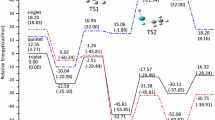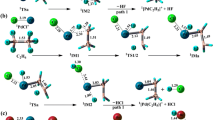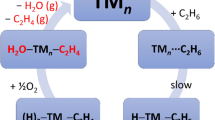Abstract
Density functional theory has been employed to investigate the ligand effect in the reaction of ligated NiBr+ with propane. Both initial C–H and C–C bond activation mechanisms for losses of HBr, H2, and CH4 are analyzed in terms of the topology of the potential energy surface. Losses of HBr and H2 involve three C–H activation mechanisms, that is, α,β-H, α,γ-H, and β,α-H abstractions, where the last β,α-H abstraction is the most favorable mechanism. Loss of CH4 involves initial C–C activation, but it is prevented by the high-energy barrier. When propane reacts with the open-shell ligated NiBr+, the ligand of Br in the initial C–H activation could direct abstract a H atom from propane substrate via a four-center transition state, without forming multi-σ-type bonding of Ni+, whereas the metal center in the initial C–C activation needs to experience an unfavorable three σ-type bonding (with Br, CH3, and CH2CH3), which explains why HBr and H2 are formed in the reaction of BrNi+/C3H8 and CH4 not.






Similar content being viewed by others
References
Russo N, Sicilia E (2001) Reaction of Sc+(1D, 3D) with H2O, NH3, and CH4: a density functional study. J Am Chem Soc 123(11):2588–2596
Chen Q, Chen HP, Kais S, Freiser B (1997) Gas-phase reactions of Fe(CH2O)+ and Fe(CH2S)+ with small alkanes: an experimental and theoretical study. J Am Chem Soc 119(52):12879–12888
Sicilia E, Russo N (2002) Theoretical study of ammonia and methane activation by first-row transition metal cations M+ (M = Ti, V, Cr). J Am Chem Soc 124(7):1471–1480
Michelini MC, Russo N, Sicilia E (2007) Gas-phase chemistry of actinides ions: new insights into the reaction of UO+ and UO2 + with water. J Am Chem Soc 129(14):4229–4239
Irigoras A, Elizalde O, Silanes I, Fowler JE, Ugalde JM (2000) Reactivity of Co+(3F,5F), Ni+(2D,4F), and Cu+(1S,3D): reaction of Co+, Ni+, and Cu+ with water. J Am Chem Soc 122(1):114–122
Irigoras A, Fowler JE, Ugalde JM (1999) Reactivity of Cr+(6S,4D), Mn+(7S,5S), and Fe+(6D,4F): reaction of Cr+, Mn+, and Fe+ with water. J Am Chem Soc 121(37):8549–8558
Chiodo S, Rivalta I, Michelini MC, Russo N, Sicilia E, Ugalde JM (2006) Activation of methane by the iron dimer cation. A theoretical study. J Phys Chem A 110(45):12501–12511
Sunderlin LS, Armentrout PB (1988) Methane activation by Ti+: electronic and translational energy dependence. J Phys Chem 92(5):1209–1219
MacMahon TJ, Jackson TC, Freiser BS (1989) A gas-phase study of FeSn+ (n = 1–6). J Am Chem Soc 111(2):421–427
Sodupe M, Charles WBJ (1991) Theoretical study of the bonding of the first- and second-row transition-metal positive ions to acetylene. J Phys Chem 95(22):8640–8645
Blomberg MRA, Siegbahn PEM, Nagashima U, Wennerberg J (1991) Theoretical study of the activation of alkane carbon–hydrogen and carbon–carbon bonds by different transition metals. J Am Chem Soc 113(2):424–433
Perry JK, Ohanessian G, Goddard WA (1993) Molecular complexes of small alkanes with Co+. J Phys Chem 97(20):5238–5245
Chen YM, Armentrout PB (1995) Guided ion beam studies of the reactions of Ag+ with C2H6, C3H8, HC(CH3)3 and c-C3H6. J Phys Chem 99(29):11424–11431
Hornung G, Schrijder D, Schwarz H (1995) Diastereoselective gas-phase carbon–carbon bond activation mediated by “bare” Co+ cations. J Am Chem Soc 117(31):8192–8196
Cornehl HH, Heinemann C, Schroder D, Schwarz H (1995) Gas-phase reactivity of lanthanide cations with hydrocarbons. Organometallics 14(2):992–999
Chen YM, Armentrout PB (1995) Activation of C2H6, C3H8, and c-C3H6 by gas-phase Rh+ and the thermochemistry of Rh-ligand complexes. J Am Chem Soc 117(36):9291–9304
Holthausen MC, Koch WA (1996) Theoretical view on Co+-mediated C–C and C–H bond activations in ethane. J Am Chem Soc 118(41):9932–9940
Noll RJ, Yi SS, Weisshaar JC (1998) Bimolecular Ni+(2D5/2) + C3H8 reaction dynamics in real time. J Phys Chem A 102(2):386–394
Yi SS, Blomberg MRA, Siegbahn PEM, Weisshaar JC (1998) Statistical modeling of gas-phase organometallic reactions based on density functional theory: Ni++ C3H8. J Phys Chem A 102(2):395–411
Blomberg M, Yi SS, Noll RJ, Weisshaar JC (1999) Gas-phase Ni+ (2D5/2)+ n-C4H10 reaction dynamics in real time: experiment and statistical modeling based on density functional theory. J Phys Chem A 103(36):7254–7267
Fedorov DG, Gordon MS (2000) A theoretical study of the reaction paths for cobalt cation + propane. J Phys Chem A 104(11):2253–2260
Moc J, Fedorov DG, Gordon MS (2000) A theoretical study of the reaction of Ti+ with ethane. J Chem Phys 112(23):10247–10258
Li FX, Zhang XG, Armentrout PB (2006) The most reactive third-row transition metal: guided ion beam and theoretical studies of the activation of methane by Ir+. Int J Mass Spectrom 255–256:279–300
Armentrout PB (2006) Activation of CH4 by gas-phase Mo+, and the thermochemistry of Mo-ligand complexes. J Phys Chem A 110(27):8327–8338
Armentrout PB, Shin S, Liyanage R (2006) Guided-ion beam and theoretical study of the potential energy surface for activation of methane by W+. J Phys Chem A 110(4):1242–1260
Armentrout PB (2007) Activation of C2H6 and C3H8 by gas-phase Mo+: thermochemistry of Mo-ligand complexes. Organometallics 26(23):5473–5485
Armentrout PB (2007) Activation of C2H6 and C3H8 by gas-phase Mo+: potential energy surfaces and reaction mechanisms. Organometallics 26(23):5486–5500
Parke LG, Hinton CS, Armentrout PB (2007) Experimental and theoretical studies of the activation of methane by Ta+. J Phys Chem C 111(48):17773–17787
Shayesteh A, Lavrov VV, Koyanagi GK, Bohme DK (2009) Reactions of atomic cations with methane: gas phase room-temperature kinetics and periodicities in reactivity. J Phys Chem A 113(19):5602–5611
Lv LL, Wang YC, Geng ZY, Si YB, Wang Q, Liu HW (2009) Activation of C2H6 by gas-phase Ta+: potential energy surfaces, spin-orbit coupling, spin-inversion probabilities, and reaction mechanisms. Organometallics 28(21):6160–6170
de Almeida KJ, Duarte HA (2010) Dehydrogenation of methane by gas-phase Th, Th+, and Th2+: theoretical insights into actinide chemistry. Organometallics 29(17):3735–3745
Mandich ML, Steigerwald ML, Reents WD (1986) The effects of chloro substitution on the electronic-structure of ClCr+, ClMn+, and ClFe+ and their reactivity with small alkanes. J Am Chem Soc 108(20):6197–6202
Mazurek U, Schroder D, Schwarz H (1998) Generation and reactivity of chromium fluoride cations (CrF +n , n = 0–4) in the gas phase. Collect Czech Chem C 63(9):1498–1512
Roithova J, Schroder D (2007) Bimolecular reactions of molecular dications: new reactivity paradigms and bond-forming processes. Phys Chem Chem Phys 9(19):2341–2349
Schroder D, Hrusak J, Schwarz H (1993) Ligand effects on the reactivity of iron (II) cations FeX+ in the gas phase. Ber Bunsenges Phys Chem 97(9):1085–1090
Mandich ML, Steigerwald ML, Reents WD (1986) The effects of chloro substitution on the electronic-structure of ClCr, ClMn, and ClFe and their reactivity with small alkanes. J Am Chem Soc 108(20):6197–6202
Mazurek U, Schroder D, Schwarz H (1998) Generation and reactivity of chromium fluoride cations (CrFn, n = 0–4) in the gas phase. Coll Czech Chem Comm 63:1498–1512
Schlangen M, Schwarz H, Schroder D (2007) Ligand and substrate effects in gas-phase reactions of NiX+/RH Couples (X = F, Cl, Br, I; R = CH3, C2H5, n-C3H7, n-C4H9). Chem Eur J 13(24):6810–6816
Becke AD (1993) Density-functional thermochemistry. III. The role of exact exchange. J Chem Phys 98(7):5648–5652
Lee C, Yang W, Parr RG (1988) Development of the Colle–Salvetti correlation-energy formula into a functional of the electron density. Phys Rev B 37:785–789
Chiodo S, Russo N, Sicilia E (2005) Newly developed basis sets for density functional calculations. J Comput Chem 26:175–183
Frisch MJ, Pople JA, Binkley JS (1984) Self-consistent molecular orbital methods 25. Supplementary functions for Gaussian basis sets. J Chem Phys 80:3265–3269
Zhao LM, Liu ZC, Guo WY, Lu XQ, Lin XQ, Shan HH (2008) Mechanisms for the Ni+-mediated oxidation of benzene to phenol by N2O. Chem Phys Lett 463:54–59
Rondinelli F, Russo N, Toscano M (2007) On the origin of the different performance of iron and manganese monocations in catalyzing the nitrous oxide reduction by carbon oxide. Inorg Chem 46:7489–7493
Glendening ED, Reed AE, Carpenter JE, Weinhold F NBO Version 3.1
Reed AE, Curtiss LA, Weinhold F (1988) Intermolecular interactions from a natural bond orbital, donor–acceptor viewpoint. Chem Rev 88(6):899–926
Grimme S (2011) Density functional theory with London dispersion corrections. WIREs Comput Mol Sci 1(2):211–228
Chai JD, Head-Gordon M (2008) Long-range corrected hybrid density functionals with damped atom–atom dispersion corrections. Phys Chem Chem Phys 10:6615–6620
Stefan G (2006) Semiempirical GGA-type density functional constructed with a long-range dispersion correction. J Comput Chem 27(15):1787–1799
Frisch MJ, Trucks GW, Schlegel HB, Scuseria GE, Robb MA, Cheeseman JR, Scalmani G, Barone V, Mennucci B, Petersson GA, Nakatsuji H, Caricato M, Li X, Hratchian HP, Izmaylov AF, Bloino J, Zheng G, Sonnenberg JL, Hada M, Ehara M, Toyota K, Fukuda R, Hasegawa J, Ishida M, Nakajima T, Honda Y, Kitao O, Nakai H, Vreven T, Montgomery JJA, Peralta JE, Ogliaro F, Bearpark MJ, Heyd J, Brothers EN, Kudin KN, Staroverov VN, Kobayashi R, Normand J, Raghavachari K, Rendell AP, Burant JC, Iyengar SS, Tomasi J, Cossi M, Rega N, Millam NJ, Klene M, Knox JE, Cross JB, Bakken V, Adamo C, Jaramillo J, Gomperts R, Stratmann RE, Yazyev O, Austin AJ, Cammi R, Pomelli C, Ochterski JW, Martin RL, Morokuma K, Zakrzewski VG, Voth GA, Salvador P, Dannenberg JJ, Dapprich S, Daniels AD, Farkas Ö, Foresman JB, Ortiz JV, Cioslowski J, Fox DJ (2009) Gaussian 09. Gaussian, Wallingford
Li YY, Guo WY, Zhao LM, Liu ZC, Lu XQ, Shan HH (2012) Theoretical investigation of the reaction of Mn+ with ethylene oxide. J Phys Chem A 116(1):512–519
Schmidt MW, Baldridge KK, Boatz JA, Elbert ST, Gordon MS, Jensen JH, Koseki S, Matsunaga N, Nguyen KA, Su SJ, Windus TL, Dupuis M, Montgomery JA (1993) General atomic and molecular electronic structure system. J Comput Chem 14:1347–1363
Matsunaga N, Koseki S, Gordon MS (1996) Relativistic potential energy surfaces of XH2(X = C, Si, Ge, Sn, and Pb) molecules: coupling of 1A1 and 3B1 states. J Chem Phys 104:7988–7996
Zener C (1932) Non-adiabatic crossing of energy levels. Proc R Soc Lond Ser A 137:696–702
Zener C (1933) Dissociation of excited diatomic molecules by external perturbations. Proc R Soc Lond Ser A 140:660–668
Fedorov DG, Koseki S, Schmidt MW, Gordon MS (2003) Spin–orbit coupling in molecules: chemistry beyond the adiabatic approximation. Int Rev Phys Chem 22:551–592
Moore CE (1952) Atomic energy levels, national bureau of standards. US Government Printing Office, Washington
Luo YR (2007) Comprehensive handbook of chemical bond energies. CRC Press, Boca Raton
Rodríguez-Santiago L, Sodupe M, Tortajada J (2001) Gas-phase reactivity of Ni+ with glycine. J Phys Chem A 105(22):5340–5347
Carpenter CJ, van Koppen PAM, Bowers MT (1995) Details of potential energy surfaces involving C–C bond activation: reactions of Fe+, Co+, and Ni+ with acetone. J Am Chem Soc 117(44):10976–10985
Rodríguez-Santiago L, Noguera M, Sodupe M, Salpin JY, Tortajada J (2003) Gas phase reactivity of Ni+ with urea. Mass spectrometry and theoretical studies. J Phys Chem A 107(46):9865–9874
Rodríguez-Santiago L, Tortajada J (2002) Experimental and theoretical studies on the gas phase reactivity of formamide-Ni+ complexes generated by FAB and electrosprayionization. Int J Mass Spectrom 219:429–443
Armentrout PB, Beauchamp JL (1980) Endothermic reactions of Ni+ with H2, HD and D2. Chem Phys 50(1):37–43
Liu F, Zhang XG, Armentrout PB (2005) Activation of CH4 by gas-phase Ni+ and the thermochemistry of Ni-ligand complexes. Phys Chem Chem Phys 7:1054–1064
Zhang Q, Kemper PR, Bowers MT (2001) Fe(CH4) +n and Ni(CH4) +n clusters: experimental and theoretical bond energies for n = 1–6. Int J Mass Spectrom 210–211:265–281
Sievers MR, Jarvis LM, Armentrout PB (1998) Transition-metal ethene bonds: thermochemistry of M+ (C2H4)n (M = Ti–Cu, n = 1 and 2) complexes. J Am Chem Soc 120:1891–1899
Hanratty MA, Beauchamo JL, Illies AJ, Koppen PV, Bowers MT (1988) Kinetic energy release distributions as a probe of transition-metal-mediated hydrogen–hydrogen, carbon–hydrogen, and carbon–carbon bond formation processes: reactions of cobalt and nickel ions with alkanes. J Am Chem Soc 110(1):1–14
Fisher ER, Armentrout PB (1990) Reactions of Co+, Ni+, and Cu+ with cyclopropane and ethylene oxide. Metal–methylidene ion bond energies. J Phys Chem 94(4):1674–1683
Allison J, Ridge DP (1979) Reactions of atomic metal ions with alkyl halides and alcohols in the gas phase. J Am Chem Soc 101:4998–5009
Zhao LM, Lu XQ, Li YY, Chen J, Guo WY (2012) On the gas-phase Co+-mediated oxidation of ethane by N2O: a mechanistic study. J Phys Chem A 116(12):3282–3289
Holthausen MC, Koch WA (1996) Theoretical view on Co-mediated C–C and C–H bond activations in ethane. J Am Chem Soc 118:9932–9940
Holthausen MC, Fiedler A, Schwarz H, Koch W (1996) How does Fe+ activate C–C and C–H Bonds in ethane? A theoretical investigation using density functional theory. J Phys Chem 100:6236–6242
Zhao LM, Guo WY, Liu ZC, Li YY, Lu XQ (2011) Theoretical study of the gas-phase Fe+-mediated oxidation of ethane by N2O. Theor Chem Acc 128:349–358
Perutz RN, Sabo-Etienne S (2007) The σ-CAM mechanism: σ-complexes as the basis of σ-bond metathesis at late-transition-metal centers. Angew Chem Int Ed 46:2578–2592
Acknowledgments
This work was supported by the Program for NSFC (21003158 and 21303266), Shandong Province Natural Science Foundation (ZR2011EMZ002), Taishan Scholar Foundation (ts20130929), Promotive Research Fund for Excellent Young and Middle-aged Scientists of Shandong Province (BS2012NJ015), and the Fundamental Research Funds for the Central Universities (12CX02014A, 14CX02004A, and 14CX06001A).
Author information
Authors and Affiliations
Corresponding authors
Electronic supplementary material
Below is the link to the electronic supplementary material.
Rights and permissions
About this article
Cite this article
Zhao, L., Ding, Q., Xu, W. et al. The ligand effect on the selective C–H versus C–C bond activation of propane by NiBr+: a theoretical study. Theor Chem Acc 134, 27 (2015). https://doi.org/10.1007/s00214-015-1628-4
Received:
Accepted:
Published:
DOI: https://doi.org/10.1007/s00214-015-1628-4




